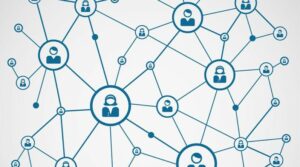Over the last 10 years, advancements in Artificial Intelligence (AI) and Machine Learning (ML) have delivered amazing applications: facial recognition, natural-sounding language generation, self-driving cars, and more. These advancements have come predominantly from the application of Neural Network algorithms which are particularly powerful at turning large-scale unstructured data into information. AI and ML-powered technologies have become integral parts of many industries, but there are still several long-term challenges that need to be addressed in order to meet the needs of the majority of potential enterprise applications which may not benefit from advances in Neural Networks. Interestingly, the same mathematical concept that underpins Neural Networks, network graphs, can support enterprises with both structured and unstructured data in becoming information-driven decision-makers.
What are Graphs?
Network graphs, and their cousin knowledge graphs, are a way to represent entities from the real world such as objects, events, individuals, situations, or concepts and their relationships. Graphs are data structures composed of nodes (usually entities) and edges (usually relationships). The most obvious network graphs people are aware of today are social networks. The nodes in those graphs are users and the edges are “follows” or “friends.” An example of a knowledge graph is Wikipedia where nodes are pages describing a concept and edges are links between pages that are relevant to one another. These tools were born about 300 years ago as a mathematical paradigm, were nurtured in the crucible of WWII optimization problems, and then scaled by the development of the internet. Graphs can support ML and AI development by simplifying data collection and management, enriching ML “featurization” (the data an AI/ML model uses to describe a problem), and providing explainability and transparency of AI/ML results (unlike neural networks).

Data Management and Featurization
The most significant challenge faced in most enterprise applications is the complexity of collecting, cleaning, and curating the right data sources for the application. Companies all over the world are working with massive data assets. The most difficult step in turning these data assets into actionable insights, predictions, and decisions is the complexity of joining those data assets across physical systems and ontological (aka meaningful relationships) divides. Using a graph structure or database allows companies to integrate new data sources, quickly leading to more responsive and comprehensive AI/ML systems.
Additionally, the performance and applicability of AI/ML models themselves can be improved by building features for ML models found via graph algorithms. These techniques can improve the usefulness of data being fed into AI/ML models allowing them to provide deeper insights that require greater data variety and data aggregation. Knowledge graphs can also help improve AI/ML models by enriching natural language text and supporting multiple schemas on the data in order to model additional complexity.
Explainability and Transparency
Another significant challenge is the need for transparency and explainability from AI/ML systems. With the increasing use of AI and ML in decision-making processes, it has become essential to understand how these systems make decisions and explain those decisions to stakeholders. Graphs, when visualized, are intuitive for humans and allow for robust explainability. Additionally, metrics on the graph can expose key data elements and relationships between those elements to human users and developers.
It’s become apparent that being data-driven is not enough, enterprises need to become knowledge-driven. In order to make this leap, stakeholders need to be able to integrate new data into the knowledge base of their AI/ML applications quickly, benefit from AI/ML built on knowledge derived from the complex relationships currently hidden by old-school data organization, and surface results of AI/ML in a human-ingestible way. Becoming a knowledge-driven organization through the application of graphs allows stakeholders to act with full context and full confidence in their decisions.
Visit us on Medium for more insight into the future of Enterprise AI
To learn more about how graph-enhanced ML can help propel your company, contact our team to set up a call <inquiries@valkyrie.ai>.



